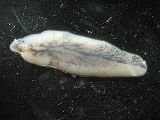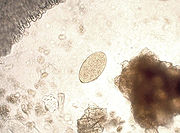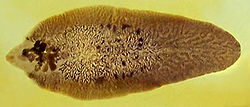
Fasciola hepatica
Encyclopedia
Fasciola hepatica, also known as the common liver fluke or sheep liver fluke, is a parasitic
flatworm
of the class
Trematoda
, phylum
Platyhelminthes that infects the livers of various mammal
s, including humans. The disease caused by the fluke is called fascioliasis
(also known as fasciolosis). F. hepatica is distributed worldwide, and causes great economic losses in sheep and cattle.
Habit and habitat:-
Animals including dogs, deer, rabit, man, monkey are carriers of fasciola hepatica.
The sheep is the main harborer of fasciola hepatica.
as an intermediate host
, such as Galba truncatula
, in which the parasite can reproduce asexually
.
Species in the family Lymnaeidae
that serve as naturally or experimentally intermediate hosts of Fasciola hepatica include: Austropeplea tomentosa, Austropeplea ollula
, Austropeplea viridis, Radix peregra
, Radix lagotis, Radix auricularia
, Radix natalensis
, Radix rubiginosa
, Omphiscola glabra
, Lymnaea stagnalis
, Stagnicola fuscus
, Stagnicola palustris
, Stagnicola turricula, Pseudosuccinea columella
, Lymnaea viatrix, Lymnaea neotropica, Fossaria bulimoides, Lymnaea cubensis, Lymnaea
sp. from Colombia, Galba truncatula
, Lymnaea cousini, Lymnaea humilis, Lymnaea diaphana, Stagnicola caperata and Lymnaea occulta.
From the snail, minute cercariae emerge and swim through pools of water in pasture, and encyst as metacercariae on near-by vegetation. From here, the metacercariae are ingested by the ruminant, or in some cases, by humans eating uncooked foods such as watercress
. Contact with low pH in the stomach causes the early immature juvenile to begin the process of excystment. In the duodenum
, the parasite breaks free of the metacercariae and burrows through the intestinal
lining into the peritoneal cavity. The newly excysted juvenile does not feed at this stage, but once it finds the liver
parenchyma
after a period of days, feeding will start. This immature stage in the liver tissue is the pathogenic stage, causing anaemia and clinical signs sometimes observed in infected animals. The parasite browses on liver tissue for a period of up to six weeks, and eventually finds its way to the bile duct
, where it matures into an adult and begins to produce eggs
. Up to 25,000 eggs per day per fluke can be produced, and in a light infection, up to 500,000 eggs per day can be deposited onto pasture by a single sheep.
 In the United Kingdom
In the United Kingdom
, F. hepatica is a frequent cause of disease in ruminants, most commonly between March and December. Cattle and sheep are infected when they consume the infectious stage of the parasite from low-lying, marshy pasture
. The effects of liver flukes are referred to as fascioliasis, and include anaemia, weight loss
and submandibular oedema; diarrhoea is only an occasional consequence. Liver fluke infestation is diagnosed by yellow-brown eggs in the faeces. They are not distinguishable from the eggs of Fascioloides magna
, although the eggs of F. magna are very rarely passed in sheep, goats or cattle.
A serious consequence of the liver
damage caused by fascioliasis is that latent Clostridium novyi
spores can be activated by the low oxygen
conditions in the damaged tracts the parasite forms in the liver; this can lead to "black disease", caused by Clostridium novyi type B or immune-mediated haemolytic anaemia (IMHA) leading to haemoglobinuria caused by C. novyi type D.
 The drug of choice in the treatment of fasciolosis is triclabendazole, a member of the benzimidazole
The drug of choice in the treatment of fasciolosis is triclabendazole, a member of the benzimidazole
family of anthelmintics. The drug works by preventing the polymerization of the molecule tubulin into the cytoskeletal structures, microtubules. However, resistance of F. hepatica to triclabendazole has already been recorded in Australia and Ireland. Artemether
has been shown to be effective in a rat model of fascioliasis.
Parasitism
Parasitism is a type of symbiotic relationship between organisms of different species where one organism, the parasite, benefits at the expense of the other, the host. Traditionally parasite referred to organisms with lifestages that needed more than one host . These are now called macroparasites...
flatworm
Flatworm
The flatworms, known in scientific literature as Platyhelminthes or Plathelminthes are a phylum of relatively simple bilaterian, unsegmented, soft-bodied invertebrate animals...
of the class
Class (biology)
In biological classification, class is* a taxonomic rank. Other well-known ranks are life, domain, kingdom, phylum, order, family, genus, and species, with class fitting between phylum and order...
Trematoda
Trematoda
Trematoda is a class within the phylum Platyhelminthes that contains two groups of parasitic flatworms, commonly referred to as "flukes".-Taxonomy and biodiversity:...
, phylum
Phylum
In biology, a phylum The term was coined by Georges Cuvier from Greek φῦλον phylon, "race, stock," related to φυλή phyle, "tribe, clan." is a taxonomic rank below kingdom and above class. "Phylum" is equivalent to the botanical term division....
Platyhelminthes that infects the livers of various mammal
Mammal
Mammals are members of a class of air-breathing vertebrate animals characterised by the possession of endothermy, hair, three middle ear bones, and mammary glands functional in mothers with young...
s, including humans. The disease caused by the fluke is called fascioliasis
Fascioliasis
Fasciolosis also known as Fascioliasis, Fasciolasis, distomatosis and liver rot, is an important helminth disease caused by two trematodes Fasciola hepatica and Fasciola gigantica. This disease belongs to the plant-borne trematode zoonoses. In Europe, the Americas and Oceania only F...
(also known as fasciolosis). F. hepatica is distributed worldwide, and causes great economic losses in sheep and cattle.
Habit and habitat:-
Animals including dogs, deer, rabit, man, monkey are carriers of fasciola hepatica.
The sheep is the main harborer of fasciola hepatica.
Life cycle
To complete its life cycle, F. hepatica requires a freshwater snailFreshwater snail
A freshwater snail is one kind of freshwater mollusc, the other kind being freshwater clams and mussels, i.e. freshwater bivalves. Specifically a freshwater snail is a gastropod that lives in a watery non-marine habitat. The majority of freshwater gastropods have a shell, with very few exceptions....
as an intermediate host
Intermediate host
A secondary host or intermediate host is a host that harbors the parasite only for a short transition period, during which some developmental stage is completed. For trypanosomes, the cause of sleeping sickness, humans are the primary host, while the tsetse fly is the secondary host...
, such as Galba truncatula
Galba truncatula
Galba truncatula is a species of air-breathing freshwater snail, an aquatic pulmonate gastropod mollusk in the family Lymnaeidae, the pond snails.Until recently, this species was commonly known as Lymnaea truncatula.-Description:...
, in which the parasite can reproduce asexually
Asexual reproduction
Asexual reproduction is a mode of reproduction by which offspring arise from a single parent, and inherit the genes of that parent only, it is reproduction which does not involve meiosis, ploidy reduction, or fertilization. A more stringent definition is agamogenesis which is reproduction without...
.
Species in the family Lymnaeidae
Lymnaeidae
Lymnaeidae is a taxonomic family of small to large air-breathing freshwater snails, aquatic pulmonate gastropod mollusks, that belong to the clade Hygrophila....
that serve as naturally or experimentally intermediate hosts of Fasciola hepatica include: Austropeplea tomentosa, Austropeplea ollula
Austropeplea ollula
Austropeplea ollula is a species of air-breathing freshwater snail, an aquatic pulmonate gastropod mollusk in the family Lymnaeidae, the pond snails.- Parasites :...
, Austropeplea viridis, Radix peregra
Radix peregra
Radix peregra, previously known as Lymnaea peregra or Lymnaea pereger, is a species of air-breathing freshwater snail, an aquatic pulmonate gastropod in the family Lymnaeidae, the pond snails....
, Radix lagotis, Radix auricularia
Radix auricularia
Radix auricularia, common name the big-ear radix, is a species of medium-sized freshwater snail, an aquatic pulmonate gastropod mollusk in the family Lymnaeidae.Radix auricularia is the type species of the genus Radix.-Forms:...
, Radix natalensis
Radix natalensis
Radix natalensis is a species of freshwater snail, an aquatic gastropod mollusc in the family Lymnaeidae.It is widely distributed in Africa. It is a major intermediate host for Fasciola gigantica in Africa. Placement of this species in the genus Radix was confirmed by Correa et al...
, Radix rubiginosa
Radix rubiginosa
Radix rubiginosa is a species of air-breathing freshwater snail, an aquatic pulmonate gastropod in the family Lymnaeidae, the pond snails.This species is sometimes treated as a subspecies of Radix auricularia.-Distribution:...
, Omphiscola glabra
Omphiscola glabra
Omphiscola glabra is a species of small to medium-size, air-breathing, freshwater snail, an aquatic pulmonate gastropod mollusk in the family Lymnaeidae.-Distribution:This European snail can be found from southern Scandinavia to southern Spain....
, Lymnaea stagnalis
Lymnaea stagnalis
Lymnaea stagnalis, better known as the great pond snail, is a species of large air-breathing freshwater snail, an aquatic pulmonate gastropod mollusk in the family Lymnaeidae.-Distribution:The distribution of this species is Holarctic...
, Stagnicola fuscus
Stagnicola fuscus
Stagnicola fuscus is a species of freshwater snail, an aquatic gastropod mollusk in the family Lymnaeidae, the pond snails.-Distribution:This species is found in the Czech Republic, Germany, the Netherlands, Croatia and other areas....
, Stagnicola palustris
Stagnicola palustris
Stagnicola palustris is a species of air-breathing freshwater snail, an aquatic pulmonate gastropod mollusk in the family Lymnaeidae, the pond snails.-Description:...
, Stagnicola turricula, Pseudosuccinea columella
Pseudosuccinea columella
Pseudosuccinea columella, common name the "American ribbed fluke snail", is a species of air-breathing freshwater snail, an aquatic pulmonate gastropod mollusk in the family Lymnaeidae, the pond snails....
, Lymnaea viatrix, Lymnaea neotropica, Fossaria bulimoides, Lymnaea cubensis, Lymnaea
Lymnaea
Lymnaea is a genus of small to large-sized air-breathing freshwater snails, aquatic pulmonate gastropod mollusks in the family Lymnaeidae, the pond snails.Lymnaea is the type genus of the family Lymnaeidae.-Species:...
sp. from Colombia, Galba truncatula
Galba truncatula
Galba truncatula is a species of air-breathing freshwater snail, an aquatic pulmonate gastropod mollusk in the family Lymnaeidae, the pond snails.Until recently, this species was commonly known as Lymnaea truncatula.-Description:...
, Lymnaea cousini, Lymnaea humilis, Lymnaea diaphana, Stagnicola caperata and Lymnaea occulta.
From the snail, minute cercariae emerge and swim through pools of water in pasture, and encyst as metacercariae on near-by vegetation. From here, the metacercariae are ingested by the ruminant, or in some cases, by humans eating uncooked foods such as watercress
Watercress
Watercresses are fast-growing, aquatic or semi-aquatic, perennial plants native from Europe to central Asia, and one of the oldest known leaf vegetables consumed by human beings...
. Contact with low pH in the stomach causes the early immature juvenile to begin the process of excystment. In the duodenum
Duodenum
The duodenum is the first section of the small intestine in most higher vertebrates, including mammals, reptiles, and birds. In fish, the divisions of the small intestine are not as clear and the terms anterior intestine or proximal intestine may be used instead of duodenum...
, the parasite breaks free of the metacercariae and burrows through the intestinal
Intestine
In human anatomy, the intestine is the segment of the alimentary canal extending from the pyloric sphincter of the stomach to the anus and, in humans and other mammals, consists of two segments, the small intestine and the large intestine...
lining into the peritoneal cavity. The newly excysted juvenile does not feed at this stage, but once it finds the liver
Liver
The liver is a vital organ present in vertebrates and some other animals. It has a wide range of functions, including detoxification, protein synthesis, and production of biochemicals necessary for digestion...
parenchyma
Parenchyma
Parenchyma is a term used to describe a bulk of a substance. It is used in different ways in animals and in plants.The term is New Latin, f. Greek παρέγχυμα - parenkhuma, "visceral flesh", f. παρεγχεῖν - parenkhein, "to pour in" f. para-, "beside" + en-, "in" + khein, "to pour"...
after a period of days, feeding will start. This immature stage in the liver tissue is the pathogenic stage, causing anaemia and clinical signs sometimes observed in infected animals. The parasite browses on liver tissue for a period of up to six weeks, and eventually finds its way to the bile duct
Bile duct
A bile duct is any of a number of long tube-like structures that carry bile.Bile, required for the digestion of food, is excreted by the liver into passages that carry bile toward the hepatic duct, which joins with the cystic duct to form the common bile duct, which opens into the intestine.The...
, where it matures into an adult and begins to produce eggs
Egg (biology)
An egg is an organic vessel in which an embryo first begins to develop. In most birds, reptiles, insects, molluscs, fish, and monotremes, an egg is the zygote, resulting from fertilization of the ovum, which is expelled from the body and permitted to develop outside the body until the developing...
. Up to 25,000 eggs per day per fluke can be produced, and in a light infection, up to 500,000 eggs per day can be deposited onto pasture by a single sheep.
Disease biology

United Kingdom
The United Kingdom of Great Britain and Northern IrelandIn the United Kingdom and Dependencies, other languages have been officially recognised as legitimate autochthonous languages under the European Charter for Regional or Minority Languages...
, F. hepatica is a frequent cause of disease in ruminants, most commonly between March and December. Cattle and sheep are infected when they consume the infectious stage of the parasite from low-lying, marshy pasture
Pasture
Pasture is land used for grazing. Pasture lands in the narrow sense are enclosed tracts of farmland, grazed by domesticated livestock, such as horses, cattle, sheep or swine. The vegetation of tended pasture, forage, consists mainly of grasses, with an interspersion of legumes and other forbs...
. The effects of liver flukes are referred to as fascioliasis, and include anaemia, weight loss
Weight loss
Weight loss, in the context of medicine, health or physical fitness, is a reduction of the total body mass, due to a mean loss of fluid, body fat or adipose tissue and/or lean mass, namely bone mineral deposits, muscle, tendon and other connective tissue...
and submandibular oedema; diarrhoea is only an occasional consequence. Liver fluke infestation is diagnosed by yellow-brown eggs in the faeces. They are not distinguishable from the eggs of Fascioloides magna
Fascioloides magna
Fascioloides magna, also known as giant liver fluke, large American liver fluke or deer fluke, is an important parasite of a variety of wild and domestic ruminants in North America and Europe. Adult flukes occur in the liver of the definitive host and feed on blood...
, although the eggs of F. magna are very rarely passed in sheep, goats or cattle.
A serious consequence of the liver
Liver
The liver is a vital organ present in vertebrates and some other animals. It has a wide range of functions, including detoxification, protein synthesis, and production of biochemicals necessary for digestion...
damage caused by fascioliasis is that latent Clostridium novyi
Clostridium novyi
Clostridium novyi a Gram-positive, endospore- forming, obligate anaerobic bacteria of the class clostridia. It is ubiquitous, being found in the soil and faeces. It is pathogenic, causing a wide variety of diseases in man and animals. It comes in three types, labelled A, B, and a non-pathogenic...
spores can be activated by the low oxygen
Oxygen
Oxygen is the element with atomic number 8 and represented by the symbol O. Its name derives from the Greek roots ὀξύς and -γενής , because at the time of naming, it was mistakenly thought that all acids required oxygen in their composition...
conditions in the damaged tracts the parasite forms in the liver; this can lead to "black disease", caused by Clostridium novyi type B or immune-mediated haemolytic anaemia (IMHA) leading to haemoglobinuria caused by C. novyi type D.
Treatment

Benzimidazole
Benzimidazole is a heterocyclic aromatic organic compound. This bicyclic compound consists of the fusion of benzene and imidazole. The most prominent benzimidazole compound in nature is N-ribosyl-dimethylbenzimidazole, which serves as an axial ligand for cobalt in vitamin B12. Benzimidazole, in...
family of anthelmintics. The drug works by preventing the polymerization of the molecule tubulin into the cytoskeletal structures, microtubules. However, resistance of F. hepatica to triclabendazole has already been recorded in Australia and Ireland. Artemether
Artemether
Artemether is an antimalarial for the treatment of multi-drug resistant strains of falciparum malaria. It is combined with Lumefantrine and sold by Novartis under the brand names Riamet and Co-Artem.-Chemical nature:...
has been shown to be effective in a rat model of fascioliasis.

